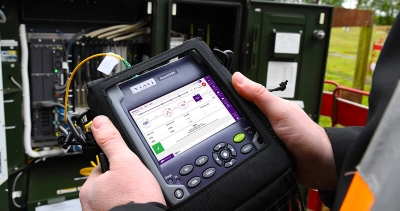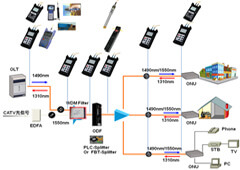How fibre testing equipment is critical for maintaining standards
Wiki Article
Checking out the Impact of Robotic Vision on Modern Manufacturing Techniques and High Quality Control
Robotic vision technology is transforming the landscape of contemporary manufacturing and quality assurance. By integrating advanced imaging systems and expert system, manufacturers can attain extraordinary degrees of accuracy and performance. This shift not just enhances production procedures but additionally addresses crucial obstacles in preserving product standards. As markets progressively count on these developments, the effects for future manufacturing practices remain to be fully explored. What will this mean for the competitive characteristics of the market?Recognizing Robotic Vision Modern Technology
Robotic vision technology works as the backbone of automation in modern-day manufacturing. It incorporates the usage of electronic cameras, sensors, and artificial knowledge to enable robotics to analyze and reply to visual information from their environment. This technology allows robotics to identify, find, and evaluate items, making them qualified of doing complex tasks such as assembly, assessment, and material handling with precision. The combination of machine knowing formulas better boosts the capacity of robotic vision systems, allowing them to adapt to differing conditions and enhance with time. By processing photos and information in real-time, robot vision systems can promote quicker decision-making and lower errors in producing procedures (fibre testing equipment). This innovation not just enhances functional performance but also guarantees that top quality requirements are satisfied constantly. As the manufacturing landscape remains to develop, recognizing the intricacies of robotic vision technology ends up being important for leveraging its possible completelyBenefits of Robotic Vision in Manufacturing
Robotic vision technology supplies substantial advantages in production by boosting accuracy and precision in tasks such as quality assurance and setting up. This boosted level of detail warranties that products meet rigid standards, decreasing waste and revamp. Additionally, the integration of robotic vision can lead to enhanced production effectiveness, allowing manufacturers to optimize their procedures and accomplish greater output rates.Improved Precision and Accuracy
In modern production, improved precision and accuracy are essential for enhancing production processes and ensuring item quality. Robotic vision systems enable devices to execute intricate jobs with amazing consistency. These systems make use of innovative imaging modern technologies to find minute details and variants in materials, parts, and ended up products. By examining aesthetic information in real-time, robotic vision substantially lowers human error, resulting in fewer defects and greater top quality standards. Furthermore, enhanced precision in measurements and positioning facilitates much better alignment in setting up processes, which is essential for detailed styles. Eventually, the assimilation of robot vision not just strengthens the dependability of making outcomes yet also fosters self-confidence among consumers concerning product honesty and efficiency. This accuracy is crucial in markets where top quality is paramount.Boosted Production Effectiveness

Makers are increasingly turning to vision systems to boost production efficiency throughout different procedures. These sophisticated systems make it possible for real-time assessment and surveillance, substantially minimizing downtime created by errors or issues. By integrating robot vision, business can automate high quality control, permitting for faster recognition of concerns and minimizing the need for human intervention. This leads to streamlined process, as robots can promptly adjust to adjustments in production needs without compromising accuracy. Furthermore, vision systems promote far better supply management by properly tracking elements and products, making certain excellent resource application. Inevitably, the fostering of robotic vision not only improves performance but additionally adds to greater result rates, decreased functional costs, and enhanced overall efficiency in the production industry.
Enhancing Quality Assurance Processes
Robotic vision technology significantly improves quality assurance processes in manufacturing by using accuracy evaluation strategies. These sophisticated systems facilitate real-time defect discovery, making certain that products meet strict quality standards. As a result, producers can reduce waste and boost overall efficiency.Precision Examination Techniques
Accuracy evaluation strategies have actually changed high quality control procedures in production, making it possible for the discovery of min defects that traditional approaches may overlook. These methods utilize progressed imaging modern technologies, such as high-resolution video cameras and laser scanning, to accomplish try here unparalleled precision. By making use of robot vision systems, makers can automate examination jobs, making certain regular performance and minimizing human error. The assimilation of artificial intelligence formulas additionally boosts these systems, allowing them to adjust and boost in time. Furthermore, precision examination assists in the identification of refined variants in item measurements and surface finishes, which can significantly influence general item high quality. Consequently, manufacturers can carry out restorative activities much more quickly, inevitably bring about lowered waste and boosted consumer contentment.Real-Time Defect Detection
Harnessing sophisticated imaging innovations, real-time defect detection transforms quality assurance processes in manufacturing. By incorporating high-resolution electronic cameras and sophisticated formulas, producers can promptly recognize anomalies during manufacturing. This technology promotes immediate corrective actions, minimizing waste and boosting overall efficiency. Real-time systems evaluate items as they relocate along the production line, guaranteeing that problems are discovered and attended to Home Page without delaying manufacturing schedules. On top of that, the implementation of artificial intelligence enhances the precision of these systems, enabling them to adjust to brand-new flaw patterns with time. Producers benefit from improved product quality and minimized functional prices. Ultimately, real-time problem discovery not just streamlines processes yet likewise promotes a culture of constant enhancement in modern manufacturing settings.Real-Time Data Evaluation and Decision Making
In the vibrant landscape of manufacturing, real-time data evaluation equips systems to make swift, educated choices. By leveraging advanced robot vision modern technologies, suppliers can collect and process vast amounts of data instantaneously. These systems analyze visual inputs to keep track of manufacturing processes, ensuring that any inconsistencies from quality criteria are detected and addressed immediately. Subsequently, makers can maximize procedures by reapportioning resources and readjusting process based upon real-time insights.Furthermore, the combination of information analytics enables predictive maintenance, where prospective tools failures are prepared for prior to they interrupt manufacturing. This proactive approach minimizes downtime and improves overall performance. robotic vision. The ability to make data-driven decisions in real time significantly reduces waste and boosts product top quality, permitting manufacturers to reply to market needs quickly. Consequently, real-time data analysis not just enhances production yet also cultivates a society of continual renovation in modern-day manufacturing atmospheres
Difficulties in Implementing Robotic Vision Equipments
Executing robotic vision systems in making provides a variety of difficulties that can prevent their performance. One considerable barrier is the complexity of integrating these systems with existing equipment and process. Producers usually encounter compatibility concerns with heritage equipment, causing boosted costs and downtime. Additionally, the irregularity in product shapes, sizes, and products can make complex the calibration of vision systems, demanding extensive training and fine-tuning.Another obstacle hinges on refining huge volumes of visual data in genuine time. High-performance computer resources are necessary, which may need further investment in framework. Additionally, there is a scarcity of competent employees efficient in managing and keeping these advanced systems, bring about potential operational ineffectiveness. Ensuring the reliability and accuracy of robot vision systems under varying environmental conditions postures a constant challenge. Addressing these concerns is essential for making the most of the possible advantages of robotic vision in manufacturing.
Future Fads in Robotic Vision for Manufacturing
As improvements in sites man-made knowledge and artificial intelligence remain to develop, the future of robot vision in manufacturing shows up significantly promising. Emerging patterns suggest a shift in the direction of more innovative imaging innovations, such as 3D vision systems and hyperspectral imaging, which will boost precision in quality assurance procedures. Integration with the Internet of Things (IoT) will allow real-time information analysis, allowing robotic systems to adapt promptly to adjustments in the production environment. Moreover, the development of collective robots (cobots) furnished with innovative vision capabilities is anticipated to help with smooth human-robot interactions, enhancing performance and safety on the manufacturing facility floor. In addition, the incorporation of edge computer will certainly equip robotic vision systems to refine data in your area, reducing latency and making it possible for faster decision-making. These developments will not only enhance producing processes however additionally greatly improve item high quality, placing robotic vision as a foundation of future industrial procedures.Frequently Asked Inquiries
Just How Much Does Robotic Vision Technology Commonly Expense?
Robotic vision innovation commonly costs between $10,000 and $100,000, depending upon the complexity and specifications. Elements influencing price consist of sensing unit quality, software program capacities, and combination needs, making it important to analyze certain job demands.What Industries Are Many Influenced by Robotic Vision Improvements?
Robotic vision advancements significantly impact sectors such as production, auto, electronics, and food processing - fibre testing equipment. These fields profit from improved automation, enhanced quality assurance, and boosted effectiveness, resulting in structured operations and reduced labor expensesCan Robotic Vision Systems Be Integrated With Existing Machinery?
Robotic vision systems can indeed be integrated with existing machinery. This combination boosts operational effectiveness, permitting suppliers to leverage advanced technologies without the demand for full overhauls, thereby optimizing production processes and keeping high quality criteria.
What Abilities Are Called For to Run Robotic Vision Solutions?
Operating robotic vision systems necessitates efficiency in programming, an understanding of artificial intelligence, understanding of image handling methods, and the capacity to fix software and hardware problems, ensuring smooth combination and suitable performance within making atmospheres.Are There Any Type Of Security Problems With Robotic Vision in Manufacturing?

Report this wiki page